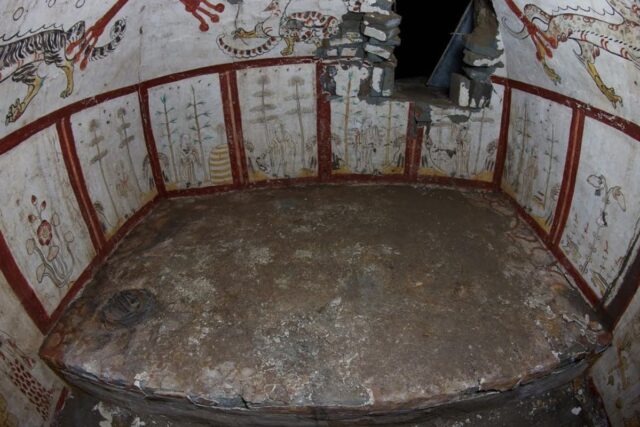A recently unearthed Tang dynasty tomb adorned with vibrant murals has shed new light on daily life in 8th-century China. This remarkable discovery includes a curious depiction of a blond, bearded figure, suggesting early interactions with Western cultures.
Unearthing The Past
In 2018, during a reconstruction project on a hillside road in Shanxi Province’s capital, a Tang dynasty tomb was discovered. However, detailed reports on the find have only emerged recently. Long Zhen, director of the Jinyang Ancient City Research Institute, described the tomb’s intricate murals, which illustrate various aspects of daily life, from women grinding flour to men pounding rice.
Daily Life And Diverse Influences
The tomb’s murals are painted in the ‘figures under the tree’ style—in which figures are shown carrying out everyday tasks under artistically rendered trees—which was a popular artistic trend during the Tang dynasty, which spanned from 618 to 907 CE. The paintings provide a glimpse into the responsibilities and routines of the time. Most figures appear to be of Han ethnicity, except for one notable exception: a blond, bearded man leading camels.
Victor Xiong, a professor at Western Michigan University, identified this figure as likely being a Sogdian from Central Asia based on his facial features and attire. The Sogdians, who lived in what is now Tajikistan and Uzbekistan, were active traders along the Silk Road, highlighting the cultural exchanges of the era.
Artistic And Cultural Significance
The murals cover nearly the entire tomb, with only the floor left unpainted. The artwork bears strong similarities to other Tang-era murals, characterized by bold outlines, simple shading, and two-dimensional representations. Zhen suggested that the style is reminiscent of the murals found in the tomb of Wang Shenzi, a prominent figure during the Tang dynasty’s decline and the Song dynasty’s rise.
The small brick tomb is adorned with paintings on its gates, corridor, and pedestal holding the coffins. The domed ceiling features a dragon-like image, while figures at the gate, possibly guardians, wear yellow robes and carry swords. Scenes within the tomb depict women in colorful dresses leading horses, men with whips, and an old man performing various tasks, all surrounded by trees, flowers, and livestock.
A Glimpse Into Tang Dynasty Life
The murals offer unprecedented insights into Tang-era chores and daily life. Xiong noted that these scenes likely portray the tomb’s owners, depicting their everyday activities. The presence of the Westerner adds a layer of mystery to this otherwise ordinary portrayal of life, hinting at the diverse cultural interactions that occurred during this period.
This discovery not only enriches our understanding of the Tang dynasty but also highlights the extensive reach of the Silk Road and its impact on cultural exchanges.
References:
Popular Mechanics: Archaeologists Found Someone They Never Expected in an Ancient Chinese Tomb: a Blonde Man
South China Morning Post: Stunning murals discovered in small Tang-era tomb depict eighth-century everyday life
World History Encyclopedia: Tang Dynasty
World History Encyclopedia: Ancient Chinese Art








